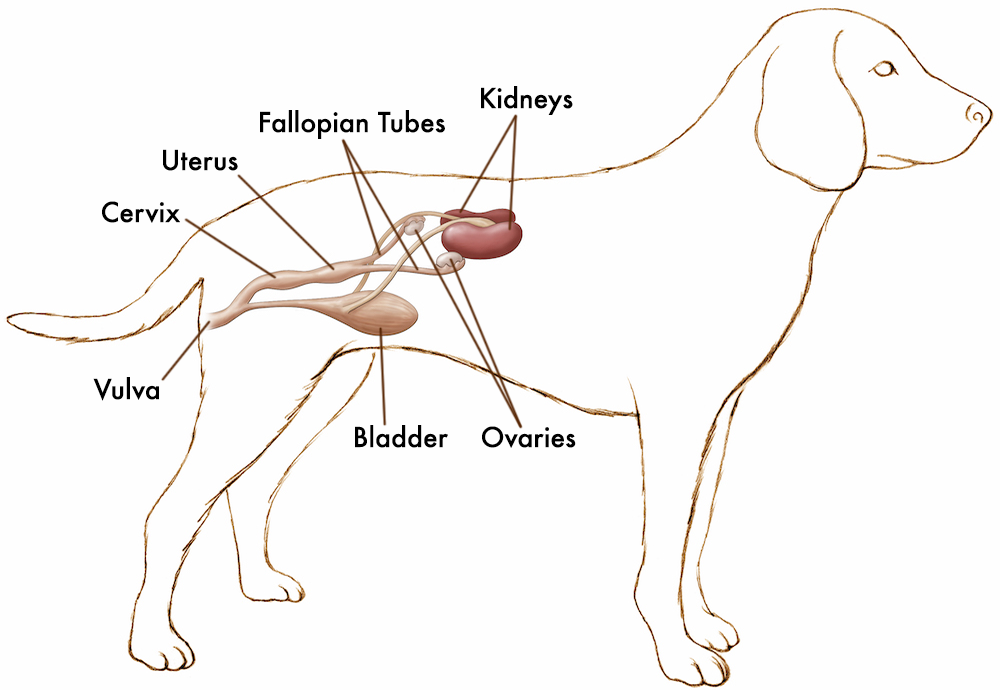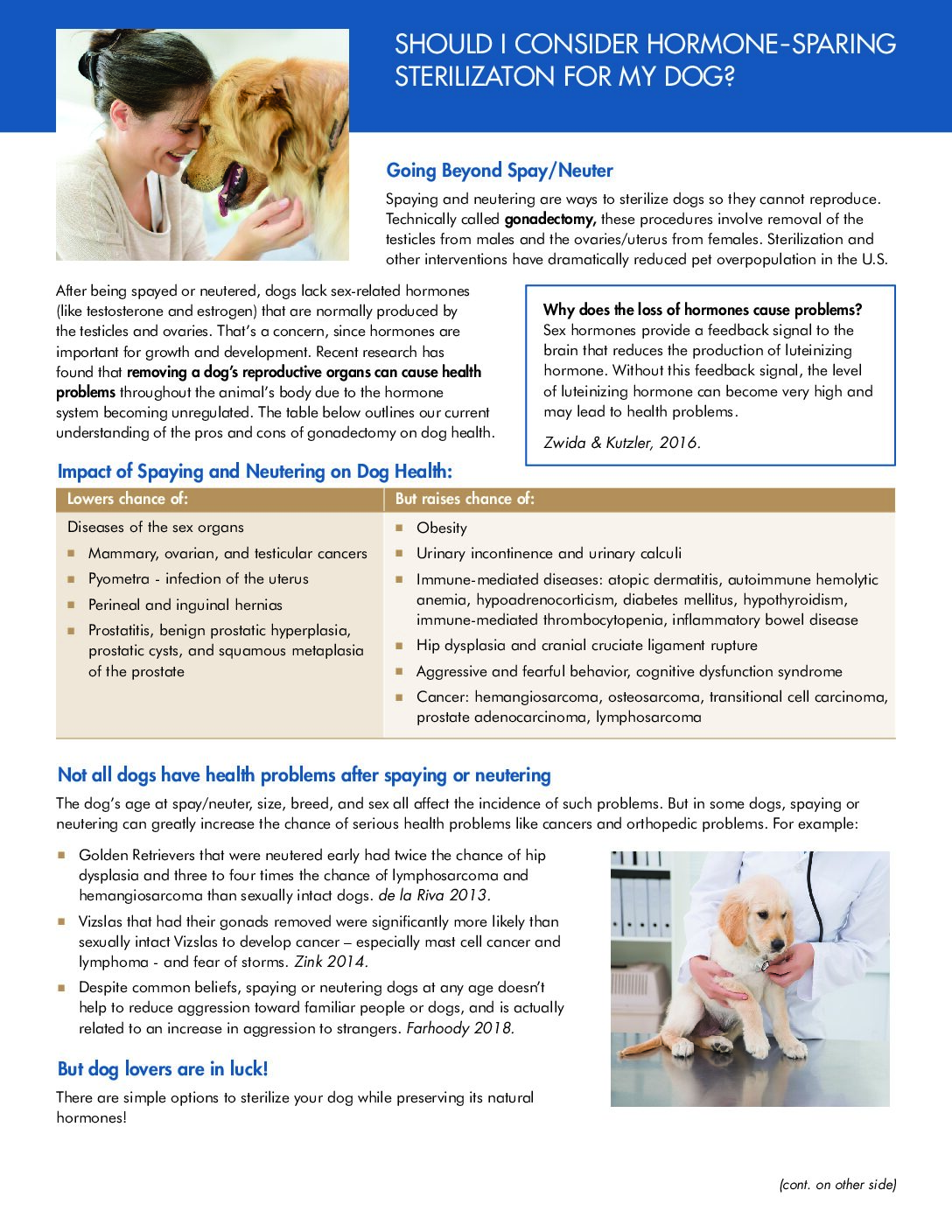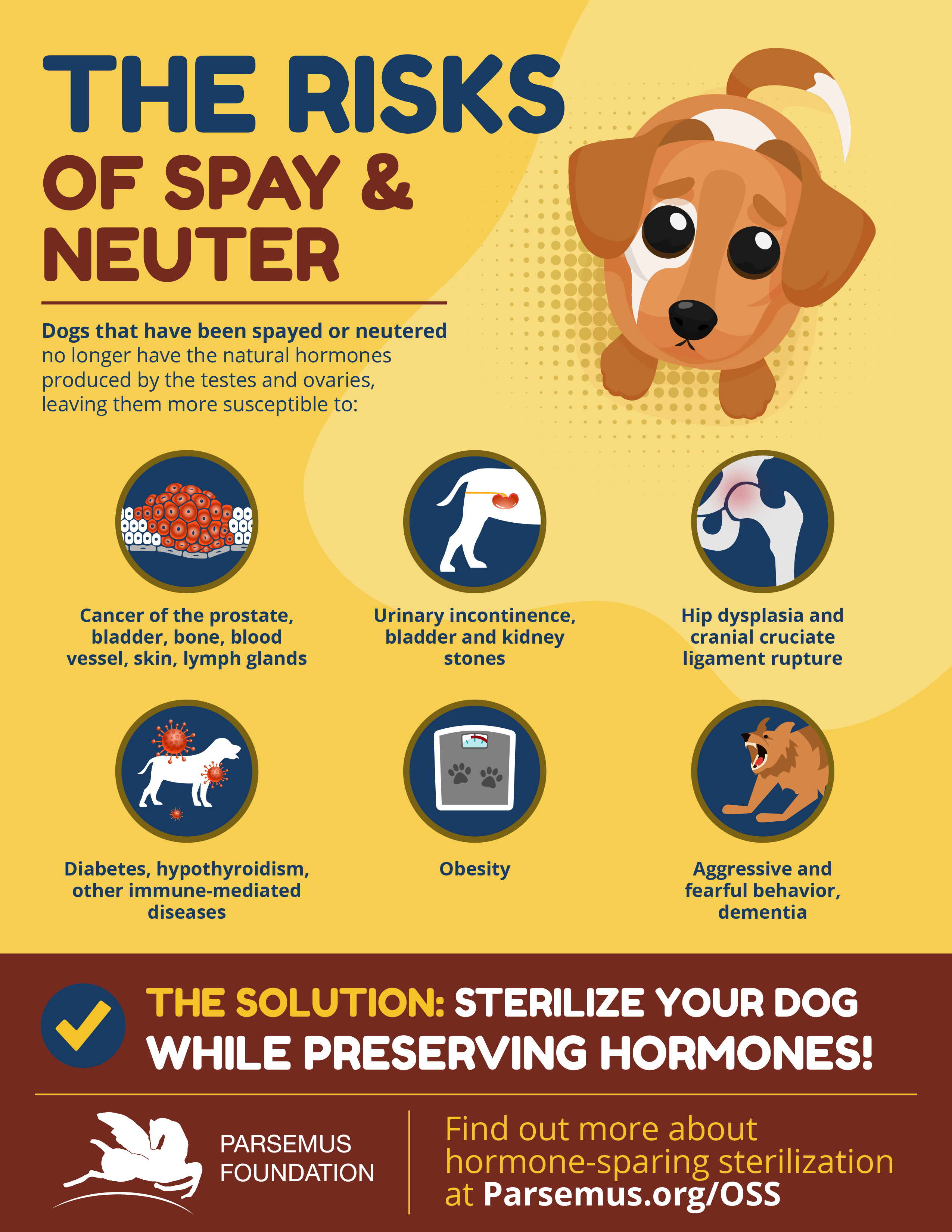PROJECT
Hormone-Sparing
Sterilization Procedures
PET HEALTH
PROJECT
Hormone-Sparing
Sterilization Procedures
PET HEALTH
Project summary
Background
- Hormone-sparing sterilization procedures, also called gonad-sparing sterilization, are ways sterilize dogs while leaving their natural hormones intact.
- For females, hysterectomy surgery that removes the uterus but leaves the ovaries intact, is most commonly practiced. It is also called ovary-sparing spay.
- For males, vasectomy surgery is performed in which the vas deferens (the tube that carries sperm) is cut or blocked so that sperm cannot flow.
- Not all veterinarians offer hysterectomy and vasectomy yet, but the number is growing.
Key points
- Hormone-sparing sterilization procedures usually include hysterectomy and vasectomy. Tubal ligation is not usually recommended because pyometra is still a concern.
- Not all veterinarians offer hysterectomy and vasectomy yet, but the number is growing.
- Other procedures, including nonsurgical or noninvasive methods, are being developed as well.
- Our Veterinary Directory can help you find a veterinarian to perform these procedures.
Parsemus' role
- The Parsemus Foundation serves as a hub to provide information to both pet owners and veterinarians on the procedures related to hormone-sparing sterilization.
- Our website and Vetarinary Directory are maintained with up-to-date information and we are always available to answer questions.
- Veterinarians seeking information on performing hysterectomy and vasectomy can find videos and details of the procedures here, and we are happy to assist in setting up consultation or training with experienced veterinarians.
Topics
- What are the options for hormone-sparing sterilization in dogs?
- How is hysterectomy or ovary-sparing spay performed in dogs?
- What about tubal ligation to sterilize female dogs?
- How is vasectomy performed in dogs?
- Other hormone-sparing sterilization procedures for male dogs
- Take action on hormone-sparing sterilization procedures
- Veterinarians offering alternative methods of contraception
Related projects

What are the options for hormone-sparing
sterilization in dogs?
All veterinarians in the U.S. are trained to complete spay and neuter surgery, which removes the gonads (ovaries in females and testes in males) and makes the pet sterile.
- Spay (ovariohysterectomy): abdominal surgery to remove the ovaries, uterus and cervix. Sometimes just the ovaries are removed (ovariectomy).
- Neuter (orchietcomy): a simpler procedure in which the testes are removed.
Very few veterinary schools train new practitioners on hormone-sparing sterilization procedures. Because the Parsemus Foundation routinely receives requests from veterinarians – and curious pet owners — about the procedures, we have included details here. We are also happy to connect veterinarians with questions to those more experienced with the procedures. Just send us a message at info@parsemus.org.
How is hysterectomy or ovary-sparing spay performed in dogs?
The most common hormone-sparing sterilization procedure for female dogs is a hysterectomy, or removal of the uterus and cervix while leaving the ovaries. It is sometimes called ovary-sparing spay (OSS) or partial spay. The procedure is not new: Belfield published on the need for the technique in 1972. OSS removes the nuisance of bleeding during heats, along with the risk of infection of the uterus (pyometra), as long as ALL of the uterus is removed. If some uterine tissue is left, “stump pyometra” may occur. More details of the technique are included in this publication and see Additional Resources for videos and other training information. (Note: the reason that tubal ligation is not usually offered to dogs is that pyometra can still occur).
Management of a female dog with a hysterectomy
The female dog will still have hormones, and may behave differently during the heat cycle. And while she cannot get pregnant, she may be attractive to males during heat — so owners may want to keep her indoors or away from intact males during this time.
What about health concerns of keeping the ovaries? Ovarian cancer is rare enough in dogs that the ovaries should not be removed just to try to prevent it. That makes mammary tumors the remaining concern. Although early studies reported a higher incidence of mammary tumors in intact dogs, a review article indicated that most of these studies were biased, making conclusions suspect (Beauvais et al., 2012). In one study, mammary tumors were reported in 1.25% of older female dogs, with higher incidence in poodles, English cocker spaniels, and dachshunds (Zatloukal et al., 2005). Luckily, mammary tumors are pretty easy to detect when rubbing your dog’s belly, and prognosis for the tumors that become cancerous is good when they are caught early and removed. Thus, many believe the low health risk associated with natural hormones is preferable to the more serious potential health risks of traditional spay. Ovary-sparing spay is approved by the American Veterinary Medical Association.
See “Additional Resources” below for details and training materials on OSS.
What about tubal ligation
to sterilize female dogs?
You might wonder why tubal ligation (which is common in humans) is not normally recommended for dogs. In this procedure, only the fallopian tubes are blocked, cut, or tied to prevent eggs from entering the uterus for fertilization. But about 25% of dogs get pyometra — a serious disease that affects the uterus and cervix and often requires emergency surgery. A hysterectomy that removes ALL the cervix and uterine tissue avoids the possibility of pyometra — a major advantage over tubal ligation.
How is vasectomy
performed in dogs?
Vasectomy in dogs is similar to the procedure for men. Each vas deferens (a tube that carries sperm from the testes and epididymis to the urethra during ejaculation) is cut or clamped so that sperm cannot move through. The procedure is completed under anesthesia but is relatively quick and simple. Technical details can be found here. This method of sterilization is accepted by the American Veterinary Medical Association.
Managing a male dog with a vasectomy
There are few health concerns when completing a hormone-sparing sterilization on a male dog, since the only health conditions prevented by neuter are benign prostatic hyperplasia in older dogs (which is treatable by neuter or noninvasive electromagnetic therapy), and testicular cancer (which is also a disease of old age and is treated by castration, which is usually curative).
The dog will be sterile but will still have hormones and be attracted to females in heat. Thus, owners must be willing to keep their dogs from roaming in search of females.
Other hormone-sparing sterilization procedures for male dogs
Epididymal sterilization
Immature sperm leave the testes and travel to the epididymis, where they mature and are stored until needed. Methods aimed at the epididymis, rather than the testes, have the advantage of stopping sperm while preserving natural hormones (which are made in the Leydig cells of the testes).
Several epididymal sterilization studies show promise for this as a hormone-preserving sterilization method. Calcium chloride dihydrate solution is an effective chemosterilant that is normally injected into the testes to cause sterility and a significant drop in testosterone. But when injected into the epididymis, calcium chloride provides a nonsurgical hormone-preserving option for male dogs (see our Calcium Chloride Male Sterilization page).
A recent study by Leoci and colleagues confirms that sterility can be achieved with an intra-epididymal injection of calcium chloride in dogs, with no drop in serum testosterone. However, the procedure required ultrasound guidance and took as long as castration. Intra-epididymal use of calcium chloride may be best for dogs who cannot tolerate surgery or whose owners do not wish to have any change in behavior or anatomy.
Sotradecol is an inexpensive drug commonly used as a sclerosant to collapse spider veins in humans. Although it has not been tried, foaming sotradecol might be an optimal epididymal injection, sclerosing the epididymis and staying in place more than a liquid sterilant. This prior art description of epididymal sotradecol injection provides more information on the approach.
Another epididymal approach tested in rams is epididymal ligation. This is an interesting, extremely simple, low-cost technique. It might not work in dogs because of anatomical differences in epididymal size and position, but has not been tried to our knowledge.
Ultrasound
Ultrasound is a non-invasive sterilization treatment for males using equipment commonly available in medical offices. Raffaella Leoci is the primary investigator who published two studies in dogs; a 2009 publication can be found online, and the 2015 publication details the exact methods necessary for effectiveness in mid-size dogs. This method has not progressed because permanent sterilization depends on specific equipment settings.
Vasalgel
Vasalgel is a contraceptive that is currently being developed for humans, but the concept is also applicable to dogs and other species. It’s a polymer gel that’s injected into the vas deferens (the tube that carries the sperm), which blocks the sperm but allows fluids to pass through. The procedure does not affect hormones. It’s being developed as a reversible contraceptive option for men by NEXT Life Sciences.
Zeuterin/Esterisol
This was an intra-testicular injection of zinc gluconate neutralized by arginine that reduced — but did not eliminate — testosterone in male dogs (*Please note that Zeuterin was approved by the FDA, but has not been available since early 2016.).
Take Action on
Hormone Sparing Sterilization
For Veterinarians
- Veterinarians who wish to be listed in our Veterinarian Directory should fill out our clinic registration form.
- Use this flyer as an informational piece for your website or as a handout for clients.
- Email us at info@parsemusfoundation.org if you would like to consult with a veterinarian who is experienced with hormone-sparing sterilization.
- Review the Additional Resources below. Take note of the information about gonadectomy risks for specific breeds and mixed-breed dogs published by Hart and colleagues (2020) and stay abreast of recent updates in this rapidly evolving area of research.
For Pet Owners
- Review this flyer to understand whether hormone-sparing sterilization is right for you and your dog. Keep in mind that impacts vary on breed, size and other factors. Check the recent publications about cancer and joint disorders by dog breed and mixed-breed size.
- Consult with a veterinarian who is familiar with the health issues related to spay/neuter and familiar with hormone-sparing options. Each dog and family is different, and having an expert consultation on the best method of sterilizing your dog is important.
- To find a provider you can search the Veterinarian Directory or check the information at the Ovary Sparing Spay and Vasectomy Info Facebook Group. If you cannot find a provider nearby, you could pass along the information on this website to your own veterinarian and ask if he or she can provide the procedure. Direct him or her to the information on this website and email us at info@parsemusfoundation.org if additional assistance/advice is required.
- Please let us know if you find a veterinarian who offers OSS or vasectomy and would like to join our directory!
- If you choose to preserve your dog’s hormones, consider joining this Facebook group: Training and behavioral advice for Intact Dogs.
- Has your dog already been spayed or neutered? See information about hormone restoration for dogs.
Veterinarians offering alternative methods of contraception
For Pet Owners
Looking for a veterinarian willing to perform procedures beyond surgical spay or neuter? Browse our directory of qualified veterinary professionals.
Veterinarian
Directory
For Veterinarians
Do you offer alternative methods of contraception like ovary-sparing spay and vasectomy? Join our referral directory so new clients can find you.
Additional resources
Hysterectomy and vasectomy training materials
- Kutzler M. 2021 Alternatives in sterilization and contraception in dogs Presentation at AMVAC Conference.
- Kutzler M. 2020 Gonad-sparing surgical sterilization in dogs. Frontiers in Vet Sci. Good overview article with description of procedures and images of OSS surgery.
- Romagnoli S, Krekeler N, de Cramer K, et al. 2024. WSAVA guidelines for the control of reproduction in dogs and cats. J. Small An Prac May 28. Details and images of procedures.
- For an informative overview of ovary-sparing spay, view the Powerpoint lecture: Hysterectomy by Dr. Michelle Kutzler.
- Human vasectomy guidelines: American Urological Association Vasectomy Guidelines (published 2012; amended 2015).
Epididymal sterilization references
- Bowman TA, Senger PL, Koger LM et al. 1978. Blockage of Sperm Transport Using Intraepididymal Calcium Chloride Injections in Rams. J Anim Sci 46(4):1063-1065. Free full text.
- Gur FM, Timurkaan S, Timurkaan N. 2011. The effects of prepubertal epididymal ligation upon androgen receptor distribution in the rat caput epididymis. Veterinarni Medicina 56(6): 286–293. Free full text.
- Leoci R, Aiudi G, Cicerelli V, et al., 2019. Effects of intratesticular vs intraepididymal calcium chloride sterilant on testicular morphology and fertility in dogs. Theriogenology 127:153-160. Free full text.
- Pineda MH, Reimers TJ, Faulkner LC, et al. 1977. Azoospermia in dogs induced by injection of sclerosing agents into the caudae of the epididymides. Am J Vet Res 38(6):831-8. Abstract.
- Pineda MH, Hepler DI. 1981. Chemical vasectomy in dogs. Long-term study. Theriogenology 16(1):1-11. Abstract.
- Pineda MH, Dooley MP. 1984. Surgical and chemical vasectomy in the cat. Am J Vet Res 45(2):291-300. Abstract.
- Tamadon A, Nikahval B, Sepehrimanesh M et al. 2010. Epididymis ligation: a minimally invasive technique for preparation of teaser rams. Veterinary Surgery 39:121-127. Free full text










